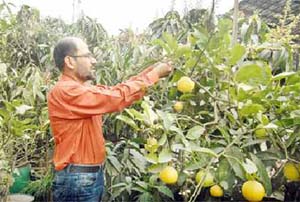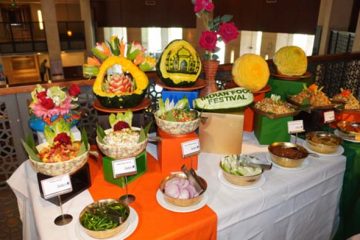City gardeners, experts for making roof gardening compulsory
 Rooftop gardening becomes growingly popular in the Dhaka city as the land for gardening shrinks every day with construction of more and more new buildings.
Rooftop gardening becomes growingly popular in the Dhaka city as the land for gardening shrinks every day with construction of more and more new buildings.
City’s gardeners and agriculturists, however, cite yet another reason why more house owners getting keen on having a patch of greenery on their roofs, which is, they want vegetables and fruits fresh and free from poisonous chemicals.
The government Department of Agricultural Extension said around 6,000 rooftop gardens are in the Dhaka city.
ABM Wahidur Rahman, an agriculturist of DAE posted at its Tejgaon office, said some of the gardeners also sell their produce they grow on their roofs.
The DAE has divided the Dhaka city in three areas supervised by its three offices called Metropolitan Tejgaon, Metropolitan Gulshan and Metropolitan Mohammadpur.
It has found 3082 rooftop gardens in the neighbourhoods overseen by its Gulshan office, 2000 have been spotted in areas under its Tejgaon office and 600 in the Mohammadpur neighbourhoods.
Vegetables, fruits and flowers on their roofs grown in these gardens include aubergine, tomato, bottle gourd, ash gourd, beans, pumpkin, mango, sweet tamarind, litchi, banana, lemon, orange, guava, olive, strawberry, varieties of seasonal flowers, cacti and orchids.
The mature oranges putting on yellow hue in the roof garden of a Dhanmondi apartment will arrest anyone’s attention.
The owner of the garden is Nowsher Alam who runs an export-oriented garments business. He started the garden around one and a half years ago.
‘I have bought this 2000-square feet flat with the space above on the roof just for gardening,’ said Nowsher who lives in a top-floor apartment of the house.
The garden that took a lot of his labour, time and thought now yields a great amount of fresh fruits and vegetables for the family and flowers too.
‘I have now 25 fruit plants and 50 varieties of flowers,’ said the proud ‘farmer’ who travelled the gardens in Thailand, Sweden, France and Switzerland only to gather experience.
Apart from orange (locally known as ‘malta’) the garden is laden with mango, pomegranate, guava, jujube (apel boroi), orange, sapota (sofeda), star fruit (kamranga), grape, Java apple (Jamrul) and pomelo (jambura).
For vegetables he has grown chili and mint leaves, among others. Two ‘china banyan’ plants also adorn the garden.
‘The fruits I grow are fresh, sweet and free from pesticides,’ he said.
Hasan Sarwar Alam, a resident of Katasur Housing at Mohammadpur, said he has also grown vegetables, fruits and flowers altogether but in a much planned way in a 1500-square feet space on the roof.
‘I’ve collected the saplings from local nurseries,’ said Sarwar Alam, adding his wife and domestic helps also take care of the plants.
Nilufar Yeasmin, agriculture officer for DAE’s Gulshan, said many people in the area produce good quality mushrooms too on their roof gardens.
Green Roof Movement, an organisation of roof-gardeners, observed such gardens are increasing in the city.
‘We need to make people aware more about the potential of roof gardens,’ said organisation’s general secretary Mohammad Golam Haider.
He suggested that the city’s housing authority, Rajdhani Unnayan Kartipakkha, and the apex body of real estate companies, Real-estate and Housing Association of Bangladesh, should sit together and discuss how space can be created in the new buildings to make roof gardens.
Golam Haider also said the country’s building code should make roof gardening compulsory for house owners in the city.
Mahfuz Hossain Mirdah, deputy director of ‘Integrated quality horticulture development project’ of DAE, said currently less than one per cent of the existing space on the building roofs is utilised for gardening.
Citing data of Dhaka City Corporation collected around three years ago he said at that time the city and its adjacent areas had around 3.5 lakh holdings with as many houses.
Most of these houses are buildings and this means the roofs altogether could provide space equivalent to 30 thousand bigha (1 bigha = 33 decimals), Mirdah said.
‘This means all this space lies entirely unutilised,’ he added.
Habibur Rahman Mian, another agriculturist of DAE posted at its head office Khamarbari, further suggested that vegetables including aubergine and tomato can be grown in the cornice and sun-shades of buildings.
‘These spaces get enough sunlight at least four hours a day which is enough for growing these vegetables,’ he added.
Courtesy of New Age

















